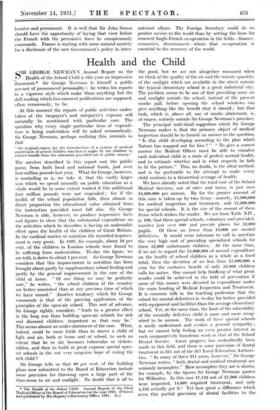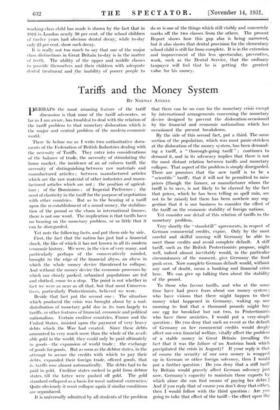Health and the Child
SIR GEORGE NEWMAN'S Annual Report on the Health of the School Child is this year an impressive document:* Sir George Newman is himself a public servant of pronounced personality-; lie writes his reports in a vigorous style which make them anything but the dull reading which Government publications are supposed, often erroneously, to be.
• At this moment the reports of public activities under- taken at the taxpayer's and ratepayer's expense will naturally • be scrutinized with particular care. The question why every single particular item of expendi- ture is being undertaken will be asked remorselessly. Sir George 'Newman, perhaps realizing this, reminds us that
"the original reason for the introduction of a system of medical supervision of school children was that it might fit the children to receive benefit from the education provided out of public money."
The services described in this report cost the public purse, from both local and national funds, just over four million pounds-last year. What Sir George, however, is reminding us is, we take it, that the vastly larger sum which we spend annually on public education as a whole would be to some extent wasted if this additional four million pounds were not expended ; for if the health of the school population falls, then almost in direct proportion the educational value obtained from the instruction provided must fall also. Sir George Newman is able, however, to produce impressive facts and figures to show that the substantial expenditure on the activities which he describes is having an undeniable effect upon the health of the children of Great Britain. In the cardinal matter of nutrition the recorded improve- ment is very great. In 1907, for example, about 10 per cent. of the children in London schools were found to be suffering from malnutrition. To-day the figure, we are told, is down to about 1 per cent. Sir-George Newman considers that this improvement in nutrition has been brought about partly by supplementary school feeding and partly by the general improvement in the care of the child at home. " Of one thing we may be perfectly sure," he writes, " the school children of the country are better nourished than at any previous time of which we have record." . Another tendency which Sir George commends is that of. the growing application of the principles of the open-air school. This sort of advance, Sir George rightly considers, " leads to a greater effect in the long run than building open-air schools for sick and diseased children, important as that may be." This seems almost an under-statement of the case. What, indeed, could be more futile than to starve a child of light and air, both at home and at school, to such an extent that he or she becomes tubercular or rickets- ridden, and then to build at great expense special open- air schools in the not very sanguine hope of curing the sick child ?
Sir -George tells us that 80 per cent. of the building plans now submitted to the Board of Education include some provision for throwing open a large part of the class-room to air and sunlight. No doubt that is all to * The Health of the School Child. Annual Report of the Chief Medical Officer of the Board of Education for the year 1930. (Printed and published by His-Majesty's Stationery Office, 1-931. 29.) the good, but we are not altogether reassured when we think of the quality of the air and the minute quantity of the sunlight which are available in the street outside the typical elementary school in a great industrial city. The problem seems to be one of first providing some air and sunlight outside the school, instead of the present smoke pall, before opening the school windows can give anything like the benefit that it should ; but that task, which is, above all, one of smoke abatement, is, of course, entirely outside Sir George Newman's province.
The principal individual suggestion which Sir George Newman makes is that the primary object of medical inspection should be to furnish an answer to the question, Is this child developing according to the plan which Nature has mapped out for him ? " " To give a correct answer the Medical Officer must be able to visualize each individual child in a state of perfect normal health, and to estimate whether and in what respects he fails to fit the picture." This, no doubt, is the ideal method, and is far preferable to the attempt to make every child conform to a theoretical average of health.
- We have already noted that the total cost of the School Medical Services, out of rates and taxes, is just over £4,000,000 per annum. By far the greater amount of this sum is taken up by two items—namely, £1,800,000 for medical inspection and treatment, and £1,600,000 for special schools. It is the size of the second of these items which strikes the reader. We see from Table XIV., p. 108, that these special schools, voluntary and provided, number just over 600 and provide places for . 52,Q00 pupils. Of these no fewer than 16,000 are mental defectives. it would seem inhuman to call in question the very high cost of providing specialized schools for these 52,000 unfortunate children. At. the same time, if we arc to regard the £4,000,000 of annual expenditure on the health of school children as a whole as a fixed total, then the devotion of no less than £1,600,000 a year for the exclusive benefit of only 52,000 children calls for notice. One cannot help thinking of what great results could be achieved in the field of prevention if some of this money were devoted to expenditure under the main heading of Medical Inspection and Treatment. It is common talk in the teaching profession that the school for mental defectives is to-day far better provided with equipment and facilities than the average elementary school. Yet, at the same time, the limit of the educability of the mentally defective child is more and more recog- nized to be narrow. The work of these special schools is easily understood and evokes a general sympathy ; but we cannot help feeling an even greater interest in such comparatively humdrum work as that of the School Dental Service. Great progress has undoubtedly been made in this field, and there is some provision of dental treatment in 311 out of the 317 Local Education Authori- ties. " In many of these 811 areas, however," Sir George Newman writes, " both dental and medical treatment are seriously incomplete." How incomplete they are is shown, for example, by the figures Sir George Newman quotes for Willesden. In this ease 17,152 out of 21,000 children were inspected, 14,009 required treatment, and only 4,192 actually got it t Yet how great a difference which even this partial provision of dental facilities to the working-class child has made is shown by the fact that in 1913 in London nearly 50 per cent. of the school children of twelve years had obvious dental decay, while to-day only 25 per cent. show such decay.
It is really not too much to say that one of the major class distinctions in Great Britain to-day is in the matter of teeth. The ability of the upper and middle classes to provide themselves and their children with adequate dental treatment and the inability of poorer people to do so is one of the things which still visibly and concretely marks off the two classes from the others. The present Report shows how this gap also is being narrowed, but it also shows that dental provision for the elementary school child is still far from complete. It is in the extension and improvement of this less spectacular, preventive, work, such as the Dental Service, that the ordinary taxpayer will feel that he is getting the greatest vahte for his money.



































 Previous page
Previous page